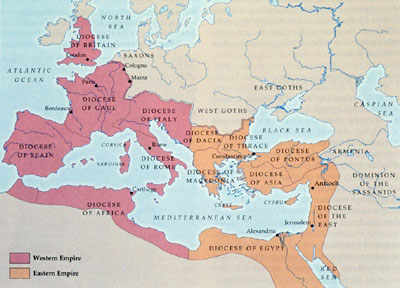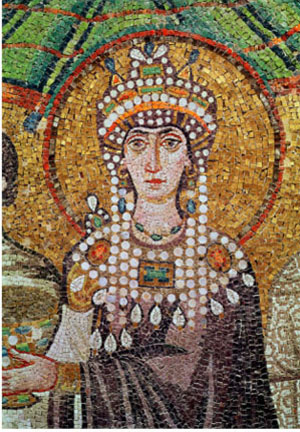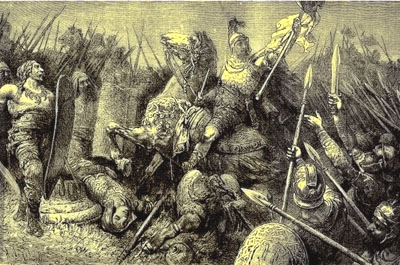Theology of History
 |
 |
 |
 |
 |
 |
 |
The Roman Empire & the Church - III
Justinian, an Eagle Soaring on High…
If Byzantium would have fulfilled its mission regarding the West, it would have done what the Franks did afterwards. Byzantium should have fought for the restoration of the Faith and the defeat of the Arian heresy in Europe. It failed to do this, but there was one man who took this task seriously. This man was Justinian (482-565), who is known today as the greatest Emperor of the Eastern Roman Empire. Justinian was one of those men who appear to have been born predestined to great things.
I have the impression that just as there are men who are called to an eminent sanctity from an early age, so also there are other men who are called to accomplish eminent tasks in the temporal order at the service of Christendom, assisted by the saints who live in their times. These men are gifted with such extraordinary personal and natural qualities that it is astounding.
 Justinian was one of these men. He was the nephew of the Eastern Emperor Justin. He reigned from 527 to 565. In appearance, he was a handsome man with a great aristocratic presence and majesty. He was very intelligent and a true jurist. Today we know from History that Justinian presided over all the important meetings of the codification of the Roman Law. He had an auxiliary, the magistrate Tribonian, but it was Justinian who personally directed the codification process, which preserved the principal elements of the Roman Law we know today.
Justinian was one of these men. He was the nephew of the Eastern Emperor Justin. He reigned from 527 to 565. In appearance, he was a handsome man with a great aristocratic presence and majesty. He was very intelligent and a true jurist. Today we know from History that Justinian presided over all the important meetings of the codification of the Roman Law. He had an auxiliary, the magistrate Tribonian, but it was Justinian who personally directed the codification process, which preserved the principal elements of the Roman Law we know today.
He was also a great builder. Just in Constantinople he built 25 churches, including St. Sophia Basilica, which alone could give a man immortal fame.
The Emperor Justin, anticipating the moment when his nephew would ascend to the throne, ensured his gifted heir was well educated in jurisprudence, theology and Roman history so that he would be prepared to direct the affairs of State.
Further, Justinian was an upright man with a strong will, a good Catholic who had austere customs and followed a clear orthodoxy in an epoch of many heresies.
The alternative Justinian faced
 As you can see on this map, Constantinople was not the geographic center of the Eastern Roman Empire, which had extended to regions around the Mediterranean. This geographical position helps us to see that the Emperor of the Eastern Roman Empire had an alternative before him:
As you can see on this map, Constantinople was not the geographic center of the Eastern Roman Empire, which had extended to regions around the Mediterranean. This geographical position helps us to see that the Emperor of the Eastern Roman Empire had an alternative before him:
Justinian took a path that was on one hand brilliant and, on the other, lamentable. That eagle, destined to soar so high, had its wings tipped with lead which prevented it from flying high. This lead was the presence of one of the most enigmatic and deplorable figures of ancient History, the Empress Theodora.
The role of Theodora
 Who was Theodora? She was a very beautiful woman, the daughter of a bear trainer for a circus in Constantinople. She herself became a circus actress. With her strong and magnetic personality, she soon made a name for herself in the large and numerous artistic circle of Constantinople, Simultaneously she became one of the most scandalous women in the city. Then, she converted to the Catholic Church, left the theater life, and settled as a wool spinner in a house near the palace.
Who was Theodora? She was a very beautiful woman, the daughter of a bear trainer for a circus in Constantinople. She herself became a circus actress. With her strong and magnetic personality, she soon made a name for herself in the large and numerous artistic circle of Constantinople, Simultaneously she became one of the most scandalous women in the city. Then, she converted to the Catholic Church, left the theater life, and settled as a wool spinner in a house near the palace.
It was as a beautiful penitent spinner that Prince Justinian met her. He fell in love and married her. With her, a curse and perdition entered the life of Justinian. It was she who represented dissolution in the life of the Emperor. She became an enemy of the Faith and a supporter of the heresies, and she strove to make Justinian enter into conflict with the Holy See at the end of his life.
She also fostered intrigues between Justinian and his generals in such way that, although he did many great things, the end result was annulled by her machinations.
It was she as well who inflenced Justinian to abandon the West and encouraged him to march against the East.
Thus, we see Justinian like an eagle that begins to soar and seems to head for the highest heavens; but midway through its upward flight it starts to descend and ends by landing on the ground.
How did this tragedy occur?
The first brilliant phase of Justinian
Justinian had a great general named Belisarius. With the intent of restoring the Roman Empire of the West – therefore, following that first plan of God, before Theodora exercised her influence – Justinian sent Belisarius to the north of Africa. That whole area had been taken over by the worst barbarians, the Vandals.
Belisarius, who commanded an enormous fleet and large army, had a brilliant victory in 534 at the Battle of Tricamarum. The barbarians who had destroyed the Western Roman Empire were completely defeated by Belisarius, who took their King, Gelimer, as prisoner. With Gelimer walking in chains at his side, Belisarius paraded in glory through the streets in Constantinople on his arrival home. Reaching the main square, he delivered the spoils of war to the Emperor, as was the custom for victorious Roman Generals. By bringing Gelimer with him in chains, Belisarius showed that a Vandal was nothing when he faced a great Roman.
With this victory, the Catholic troops of Belisarius re-conquered the lost Roman provinces of north Africa from the Vandals who followed the Arian heresy. So, a part of the Mare Nostrum [our sea, the Mediterranean] was restored to the first Christendom.
With this great victory Justinian took the name Justinianus Vandalicus Africanus, to signify he had defeated the Vandals and was the conqueror of Africa.
Throughout north Africa the Church began to bloom again. The Arians were imprisoned and the Catholics reorganized. The name of Christ was again glorified along that African coast.
 After the triumph, Justinian turned to Italy to re-conquer it through two fronts of attack. The imperial troops commanded by General Mundo entered northern Italy by way of Illyria, the same path taken by the Ostrogoths earlier, while Belisarius attacked Sicily. After taking it, he entered the peninsula and captured Naples and finally Rome in 536. It was a great and symbolic triumph. The Eastern troops of Justinian had re-conquered the West. Rome was released from the barbarian dominium and again was in the possession of the Romans.
After the triumph, Justinian turned to Italy to re-conquer it through two fronts of attack. The imperial troops commanded by General Mundo entered northern Italy by way of Illyria, the same path taken by the Ostrogoths earlier, while Belisarius attacked Sicily. After taking it, he entered the peninsula and captured Naples and finally Rome in 536. It was a great and symbolic triumph. The Eastern troops of Justinian had re-conquered the West. Rome was released from the barbarian dominium and again was in the possession of the Romans.
We can imagine the joy and glory of a Catholic seeing the Roman troops marching in triumph through the streets of Rome. Decrees were published in Latin and Greek, which was the official language of the Eastern Roman Empire, to record and celebrate the restored glory of Ancient Rome.
Continued

I have the impression that just as there are men who are called to an eminent sanctity from an early age, so also there are other men who are called to accomplish eminent tasks in the temporal order at the service of Christendom, assisted by the saints who live in their times. These men are gifted with such extraordinary personal and natural qualities that it is astounding.

The Emperor Justinian
He was also a great builder. Just in Constantinople he built 25 churches, including St. Sophia Basilica, which alone could give a man immortal fame.
The Emperor Justin, anticipating the moment when his nephew would ascend to the throne, ensured his gifted heir was well educated in jurisprudence, theology and Roman history so that he would be prepared to direct the affairs of State.
Further, Justinian was an upright man with a strong will, a good Catholic who had austere customs and followed a clear orthodoxy in an epoch of many heresies.
The alternative Justinian faced

- If he desired to be great before God, he should restore the Western Roman Empire, as well as defend the Faith and the oppressed Catholics there. In this case, he should re-conquer the North of Africa, Italy, Spain and Gaul. After re-installing the Old Roman Empire to its former boundaries, he should then defend that first Christendom.
- If he desired to be great before men, working for his own glory, he would leave aside this task and turn instead to the East. Along with maintaining the Empire’s lands in Asia Minor, he would strive to conquer Mesopotamia and Persia, which were very wealthy and prestigious lands with a grand culture. They were, however, pagan, so radically pagan that the peoples there had almost completely rejected the evangelization of the Apostles. Most probably they would not be converted to Catholicism through an action of the Eastern Roman Empire. The conquest of those areas, therefore, would not have a primordial religious significance, but were important as a political conquest that would bring great personal glory to the Emperor.
Justinian took a path that was on one hand brilliant and, on the other, lamentable. That eagle, destined to soar so high, had its wings tipped with lead which prevented it from flying high. This lead was the presence of one of the most enigmatic and deplorable figures of ancient History, the Empress Theodora.
The role of Theodora

Theodora
It was as a beautiful penitent spinner that Prince Justinian met her. He fell in love and married her. With her, a curse and perdition entered the life of Justinian. It was she who represented dissolution in the life of the Emperor. She became an enemy of the Faith and a supporter of the heresies, and she strove to make Justinian enter into conflict with the Holy See at the end of his life.
She also fostered intrigues between Justinian and his generals in such way that, although he did many great things, the end result was annulled by her machinations.
It was she as well who inflenced Justinian to abandon the West and encouraged him to march against the East.
Thus, we see Justinian like an eagle that begins to soar and seems to head for the highest heavens; but midway through its upward flight it starts to descend and ends by landing on the ground.
How did this tragedy occur?
The first brilliant phase of Justinian
Justinian had a great general named Belisarius. With the intent of restoring the Roman Empire of the West – therefore, following that first plan of God, before Theodora exercised her influence – Justinian sent Belisarius to the north of Africa. That whole area had been taken over by the worst barbarians, the Vandals.
Belisarius, who commanded an enormous fleet and large army, had a brilliant victory in 534 at the Battle of Tricamarum. The barbarians who had destroyed the Western Roman Empire were completely defeated by Belisarius, who took their King, Gelimer, as prisoner. With Gelimer walking in chains at his side, Belisarius paraded in glory through the streets in Constantinople on his arrival home. Reaching the main square, he delivered the spoils of war to the Emperor, as was the custom for victorious Roman Generals. By bringing Gelimer with him in chains, Belisarius showed that a Vandal was nothing when he faced a great Roman.
With this victory, the Catholic troops of Belisarius re-conquered the lost Roman provinces of north Africa from the Vandals who followed the Arian heresy. So, a part of the Mare Nostrum [our sea, the Mediterranean] was restored to the first Christendom.
With this great victory Justinian took the name Justinianus Vandalicus Africanus, to signify he had defeated the Vandals and was the conqueror of Africa.
Throughout north Africa the Church began to bloom again. The Arians were imprisoned and the Catholics reorganized. The name of Christ was again glorified along that African coast.

Belisarius conquers the barbarians in Rome
We can imagine the joy and glory of a Catholic seeing the Roman troops marching in triumph through the streets of Rome. Decrees were published in Latin and Greek, which was the official language of the Eastern Roman Empire, to record and celebrate the restored glory of Ancient Rome.
Continued

Posted February 27, 2013
______________________
______________________











